Central Business District, Los Angeles (1880s-1890s)
During the 1880s and 1890s the central business district (CBD) of Los Angeles was located around Spring and Main streets from just south of the Los Angeles Plaza to Second Street. Of the old CBD not a single building remains except at the extreme southern edge below 2nd Street, as all structures from this period were razed to make way for the construction of the Civic Center during the 1930s–1950s.[1][2]


History
Prior to the completion of the transcontinental railroad, Los Angeles was a small town (population 1860: 4,385; 1870: 5,728) of low-lying adobe and brick buildings. Most businesses were located on or nearby the Plaza. With the arrival of the railroad the city grew in population, almost quintupling in ten years (1880: 11,183, 1890: 50,395) and businesses opened further south and west away from the Plaza; especially along Spring and Main, reaching southward to Temple, First, and Second streets.[1][2]
After the turn of the 20th century, banks, hotels, and retailers established much larger buildings along Spring and Broadway from Third Street southward, in the area today called the Historic Core. The central business district shifted to the area between Third and Ninth streets: along Broadway for retail, cinemas, and restaurants; and along Spring Street for banks and financial businesses, the Spring Street Financial District.[1][2]
The blocks north of Second Street lost prestige and began to house businesses catering to working-class and Spanish-speaking Angelenos; the buildings deteriorated.[1][2]
Maps
The area contained many streets which no longer exist or only exist outside the boundaries of the 1880s-1890s CBD. These include: Arcadia St., Buena Vista St., Center Pl., Commercial St., Ferguson St., Franklin St., Marchessault St. (now Paseo de la Plaza), Market Ct., New High St., Calle de Los Negros, and Requena St.
Maps of the area from Hill St. east to Los Angeles St. and from the Plaza south to 2nd St. in 1886, left; and today, right:

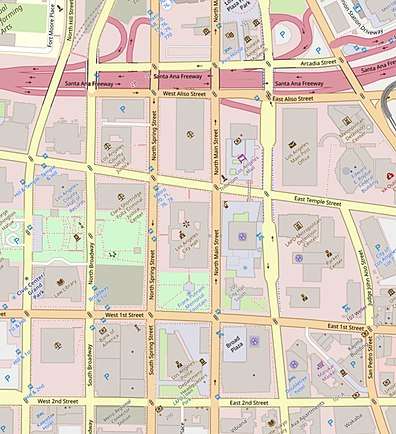
The buildings described in this article were located in the street grid as shown:
| BELLEVUE ST. | B R O A D W A Y |
BELLEVUE ST. | N E W H I G H S T R E E T |
REPUBLIC ST. | M A I N S T R E E T |
PLAZA | L O S A N G E L E S S T R E E T | |||
| Temperance Temple (NW corner Temple/Broadway) |
-Lafayette Hotel
|
Pico House Merced Theater Arcadia Block | ||||||||
| ARCADIA ST. | ||||||||||
|
-Baker Block, SE cor Main/Arcadia
| ||||||||||
| COMMERCIAL ST. | ||||||||||
| TEMPLE ST. | TEMPLE ST. | TEMPLE ST. | ||||||||
|
High School (1873-1887)/ Hall of Records (1962-present) Hall of Records (1911-1973) |
Phillips Block |
S P R I N G S T R E E T |
Temple Block |
REQUENA ST. | ||||||
| MARKET ST. |
United States Hotel | |||||||||
|
Clock Tower Courthouse | ||||||||||
| COURT ST. | ||||||||||
|
Los Angeles |
||||||||||
| FRANKLIN ST. | FRANKLIN ST. | |||||||||
|
|
Times Building (1912) |
Larronde Block | ||||||||
| FIRST ST. | FIRST ST. | FIRST ST. | FIRST ST. | |||||||
| 130 - Southwest Bldg. (Chamber of Commerce) |
Nadeau Hotel (1882) |
Wilson Block |
Natick House |
|||||||
|
Frost Bldg. |
Hellman Bldg. |
Bryson-Bonebrake |
Burdick Block |
|||||||
| SECOND ST. | SECOND ST. | SECOND ST. | SECOND ST. | |||||||
|
Coulters/ |
1888 City Hall, E side B'way S of 2nd |
Hollenbeck Hotel |
Wilcox Bldg (1895-6) |
|||||||
Major buildings by street
Sources: Los Angeles Times,[2] Water & Power Associates[1] Centrally located businesses and institutions in the 1880s-1890s CBD area are listed; some were built after 1900 when the area formed part of a larger CBD, but all were demolished for the construction of the Civic Center.
Broadway
| West side | East side | |
|---|---|---|
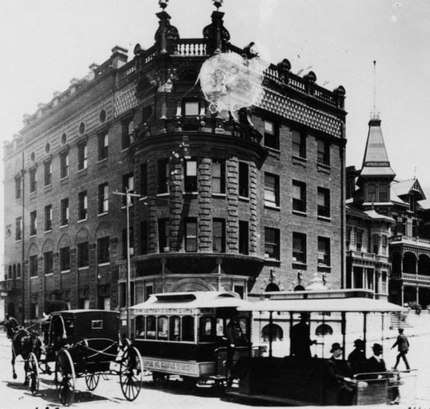 The Women's Christian Temperance Union building, also known as Temperance Temple, with a Temple Street Cable Railway car, 1890 Temperance Temple[3] |
B R O A D W A Y |
|
| TEMPLE STREET | TEMPLE STREET | |
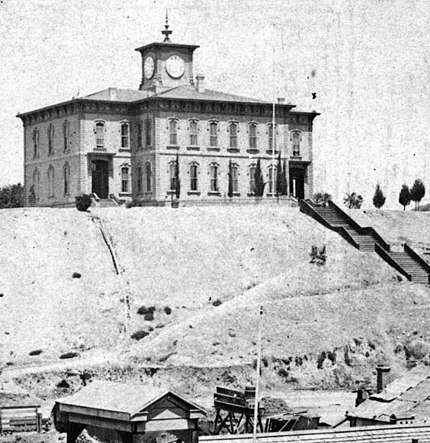 Los Angeles High School on Pound Cake Hill, 1870s Los Angeles High School original location on Pound Cake Hill (1873-1887), between New High (W) and Broadway (E), on the south side of Temple Street. It was moved to California/Sand street and in 1890 a new facility was built on Fort Moore Hill, approximately where Broadway today crosses the Hollywood Freeway and immediately north. _(14783523833).jpg) 1891 Courthouse and Post Office The Red Sandstone Courthouse on Pound Cake Hill, between New High (W) and Broadway (E), on the south side of Temple Street. It was built on the site of Los Angeles High School and replaced facilities at the Temple Courthouse. It functioned additionally as a post office and federal agency building, built 1891. Damaged beyond repair by Long Beach earthquake 1933, demolished 1936.[4] | ||
| FRANKLIN STREET | ||
%2C_photo_about_1887.jpg) Los Angeles Times Building (built 1886), photo about 1887 .jpg) Hall of Records, built 1911, demolished 1973 | ||
| FIRST STREET | ||
| C. H. Frost Bldg (1898) |
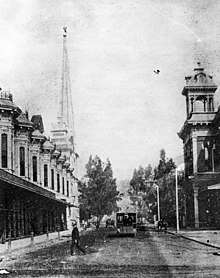 Second Street looking west from Spring Street towards Broadway. The Mirror Building on the right, mid block, north side, functioned as City Hall between 1884-1888. On the left, Hollenbeck Block, with the First Presbyterian Church (SW corner of 2nd & Broadway in the back The Mirror Building, mid-block on the north side of 2nd street between Broadway and the Bryson-Bonebrake Block on Spring, was used as Los Angeles City Hall between 1884-1888.[6][7][8] Hellman Building | |
| SECOND STREET | SECOND STREET | |
.jpg) Broadway looking south from Second Street, ca. 1895-1905. The 1888 City Hall is visible on the left (east) side.  Sketch of the west side of Broadway, 2nd to 3rd streets in the 1890s. At left: Bicknell Block; Potomac Block with Ville de Paris | ||
 American National Bank (later California Bank) Building (1878-1911), SW corner 2nd and Broadway Los Angeles around 1890 —201–205, SW corner, site of Judge O'Melveny's house (1870), replaced by American National Bank (later California Bank) Building, replaced by California Building 1911, now "Broadway Media Center"(201-213)
 Potomac Block, W side of Broadway between 2nd and 3rd, 1890s 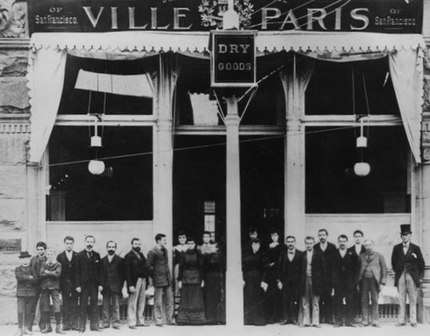 Ville de Paris (department store), 221–3 S. Broadway. Demolished. —221–223, site of Potomac Block, home toVille de Paris (department store) 1893–1905. In 1905 the Potomac Block became part of the Coulter's Department Store complex
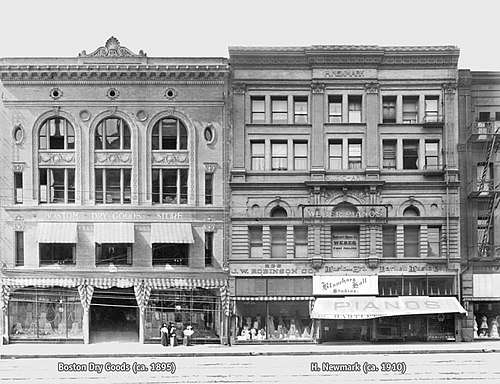 J. W. Robinson's Boston Dry Goods (237-241) and Harris Newmark (231-5) buildings, Broadway, Los Angeles, 1899 —231-235, site of Harris Newmark Building (1899, Abram Edelman), Bartlett Music Co. (#233), annex to J. W. Robinson's (#235); Goodwill Industries store (#233-235, 1950s-60s). All but the ground floor have been removed.
|
B R O A D W A Y |
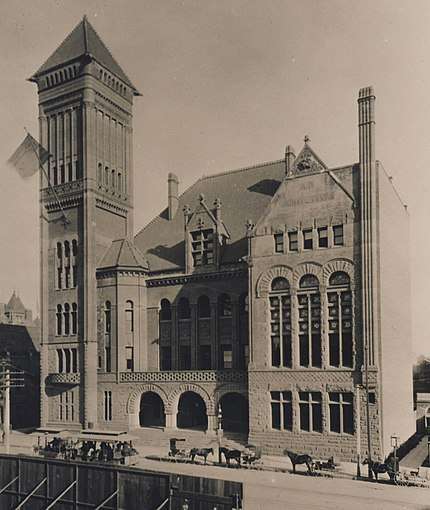 Los Angeles City Hall (built 1888) - E side of Broadway btw 2nd and 3rd City Hall (1888 location; City Hall moved to its present location in 1928, demolished 1929, now a parking lot). Three stories, 150-foot (46 m) campanile. Architect S. I. Haas. Romanesque architecture. Red and brown brick. Housed the Los Angeles Public Library for a time until it moved to the new Hamburger's department store building at 8th & Broadway in 1908.[14] |
Spring Street
| TEMPLE | S P R I N G S T R E E T |
TEMPLE |
 View north on Spring St. from First St., Phillips Block at left (west), 1890s —Phillips Block, 129–133 N. Spring St. (post-1890 numbering), 29–33 N. Spring St. (pre-1890 numbering), on the northwest corner of Spring Street and Franklin streets, backing up to New High St. at its west. Built on the site of the one-story adobe County Jail. Opened in 1888, architect Burgess J. Reeve, four and a half stories, owned by Pomona Valley rancher Louis Phillips, cost $260,000. 120 feet (37 m) of frontage on Spring St., 218 feet (66 m) on Franklin, 121 feet (37 m) along New High Street. The second four-story structure built in L.A. Sometimes called Phillips Block No. 1; there was a "Phillips Block No. 2" at 135–145 Los Angeles St., west side between Market and 1st.[15] In July 1888, A. Hamburger & Sons, "The People's Store", opened a new large store here and was the largest retail store in the Western United States.[16] |
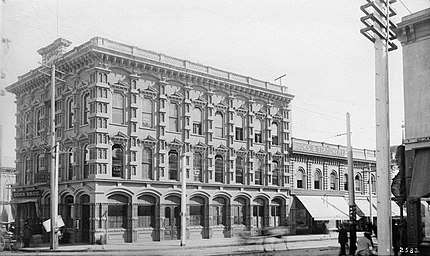 Temple Block, Los Angeles, around 1880 Temple Block: actually a collection of different structures that occupied the block between the east side of Spring, west side of Main and south side of Temple St. The first or "Old" Temple Block was of adobe, two stories, facing north to Temple. This was incorporated into the later Temple Block, and then demolished. Built 1858, expanded 1871, housing many law offices. On the ground floor retail tenants included retailers Desmond's, Jacoby Bros., Slotterbeck's gun shop; and the Wells Fargo office. | |
| MARKET ST. | ||
.jpg) Temple Courthouse with clock tower, 1885. At back, the United States Hotel at Main & Requena (Market). Clock Tower Courthouse: Just south of Temple Block across tiny Market Street, was a building known by many additional names including Temple Market, Temple Theater, Old County Courthouse, etc. Also built by John Temple, in 1858, originally as a market (ground floor) and theater (upper floor). Demolished 1890s.[17][18] Served as a market and retail as well as the County Courthouse 1861-1891 until the Red Sand Courthouse was built.[19] Topped by a rectangular tower with a clock on all four sides.[20][4] 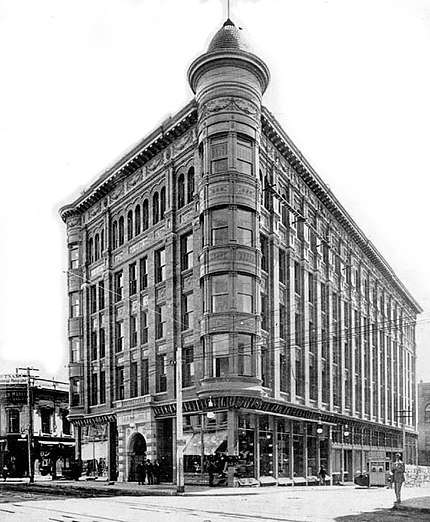 Bullard Block in 1900
| ||
| FRANKLIN ST. | COURT ST. | |
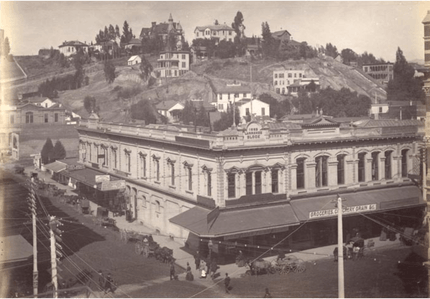 Larronde Block, NW corner 1st & Spring, 1898 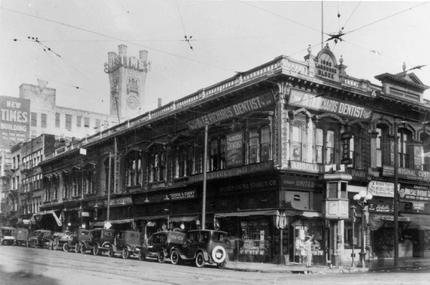 Larronde Block, NW corner 1st & Spring, undated photo, probably 1910s —Larronde Block (1882), NW corner 1st & Spring, shops and offices |
.jpg) Spring Street looking north from First towards Temple during the Fiesta de Los Ángeles 1903. The tall building at top-center is the Bullard Block, 154–160 N. Spring, NE corner of Court St., topped by a sign for The Hub, a large clothing store
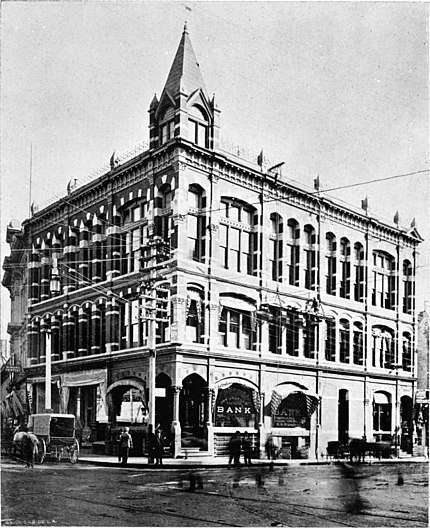 Los Angeles National Bank Building, NE corner of 1st & Spring, Kysor, Morgan & Walls, Gothic Revival architecture, 1887-1906
 Equitable Savings Bank Building, NE corner of 1st & Spring, 1906-1920s
| |
| FIRST ST. | FIRST ST. | |
.jpg) Nadeau Hotel (1881/2-1932) —Nadeau Hotel, built 1881-2, demolished 1932, Kysor & Morgan. Southwest corner of Spring and First. First four-story building in the city.[23] |
 Wilson Block, SE corner Spring & 1st as seen in 1920
| |
.jpg) Bryson or Bryson-Bonebrake Block or Building built 1886-8, photo 1905 —The Bryson Block, also known as the Bryson-Bonebrake Block or Bryson Bonebrake Building, northwest corner 2nd and Spring, built 1886-1888 for $224,000 on the site of a public school and an early city hall, as a 126-room bank and office building. Romanesque architecture. Two stories added 1902-1904. Demolished 1934. Architect Joseph Cather Newsom (Newsom & Newsom). PCAD states it was "nothing short of amazing, displaying a riotous and eclectic amalgam of features". Built for mayor John Bryson and Major George H. Bonebrake, President of the Los Angeles National Bank and the State Loan & Trust Co.[24] |
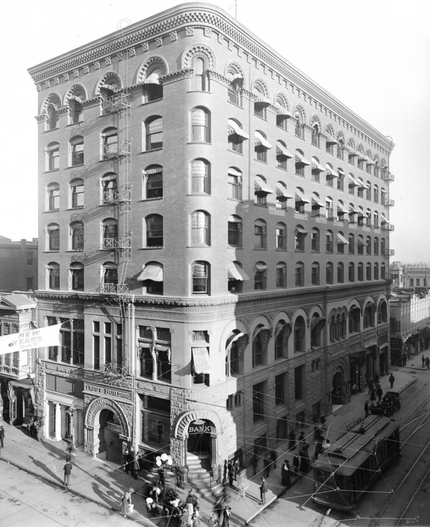 Burdick Block, NE corner 2nd & Spring, built 1888 (Jasper Newton Preston), top floors added 1900 (John Parkinson). Photo from 1902 —Burdick Block, 1888 (Jasper Newton Preston), top stories added 1900 (John Parkinson) | |
| SECOND ST. | SECOND ST. | |
.jpg) Hollenbeck Block, home to the Hollenbeck Hotel and Coulter's. SW corner Spring and 2nd. Built in 1884, demolished in 1933. Robert Brown Young, architect. —The Hollenbeck Block was located on the southwest corner of Spring and 2nd streets. It was built in 1884 by John Edward Hollenbeck and housed the Hollenbeck Hotel and, on the corner, Coulter's 6,000 sq ft (560 m2) store. Built 1884, demolished in 1933. Architect Robert Brown Young.[25] |
.jpg) Wilcox Building, built 1895-6, photo 1905
|
Spring Street Gallery
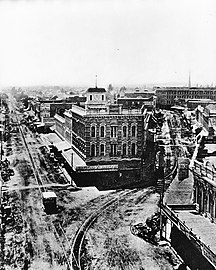 Temple Block, Los Angeles, around 1885
Temple Block, Los Angeles, around 1885 Spring & 2nd, showing Bryson Block before its added stories, 1903
Spring & 2nd, showing Bryson Block before its added stories, 1903.tiff.jpg) Spring Street
Spring Street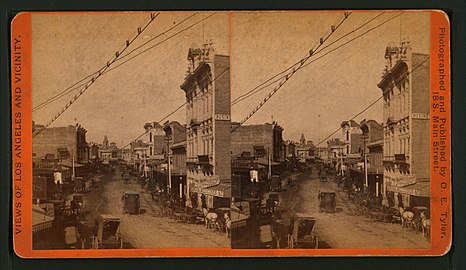 An early stereoscopic view of Spring Street
An early stereoscopic view of Spring Street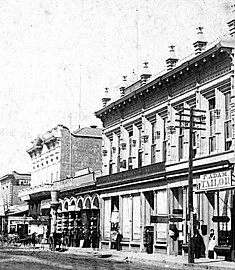 Spring Street at Court Street, 1875
Spring Street at Court Street, 1875
Spring Street Retailers
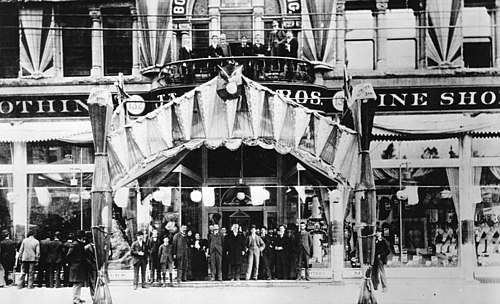 Jacoby Bros. in the Temple Block, around 1896
Jacoby Bros. in the Temple Block, around 1896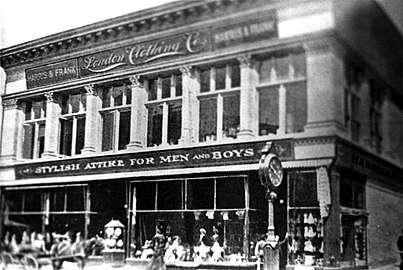 London Clothing Co. at Spring and Temple, which became Harris & Frank, a chain of stores focused on men's clothing
London Clothing Co. at Spring and Temple, which became Harris & Frank, a chain of stores focused on men's clothing
Main Street
| REPUBLIC | M A I N S T R E E T |
PLAZA |
 St. Elmo Hotel, around 1890
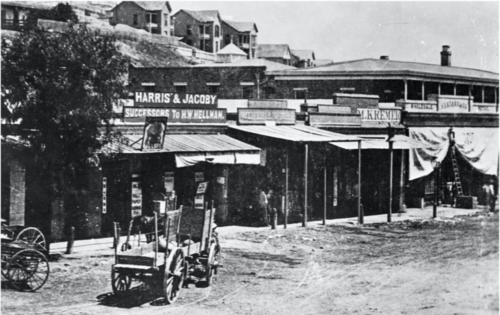 The Old Downey Block, around 1870, before Downey Block was built in 1871: "Harris & Jacoby", forerunners to Harris & Frank and Jacoby Bros., and M. Kremer, forerunner of the City of Paris, the city's first dept. store
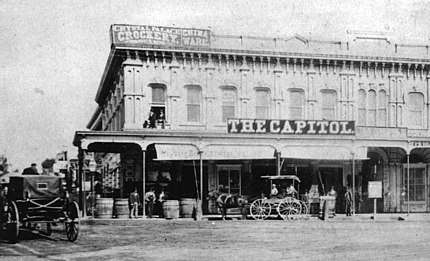 Downey Block in the 1880s  Downey Block in 1887 Downey Block (1871–1910), NW corner Main & Temple on the site of Jonathan Temple's old adobe store, the first dry goods store in Los Angeles. Romanesque Revival architecture. The first home of the Los Angeles Times, the Los Angeles Public Library and the Los Angeles Athletic Club. Housed Victor Dol's Commercial Restaurant, Jacoby Bros. and Coulter's (1878-9). 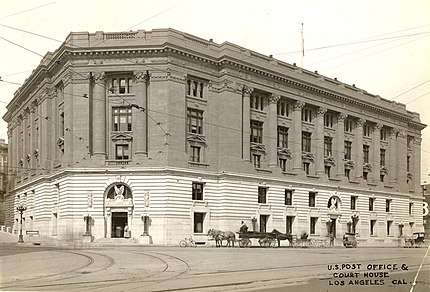 1910 Post Office and Courthouse, NW corner Temple & Main New Post Office (1910–1937), NW corner & Temple, built 1910 on the site of the Downey Block for $1,500,000. Demolished 1937, a new federal building was built on the site.[4] |
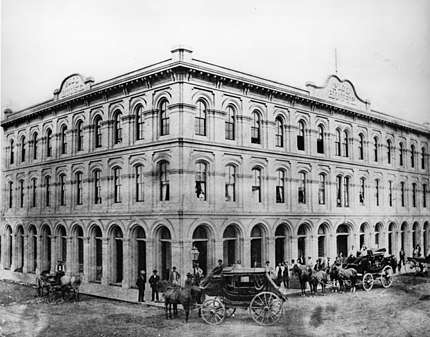 Pico House hotel
| |
| ARCADIA | ||
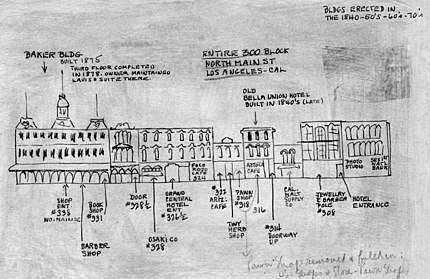 Sketch of east side of the 300 block of N. Main St., between Arcadia and Commercial streets, as it looked around 1880 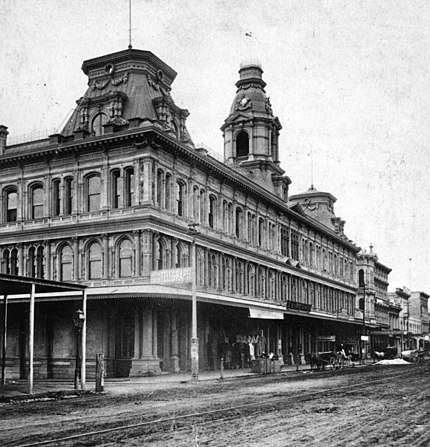 Baker Block, Los Angeles, around 1880 Baker Block, Second Empire architecture, SE corner Main and Arcadia, built 1875 (third floor added 1878). Built on the site of Don Abel Stearns' 1835-8 adobe "palacio" (mansion); Col. Robert S. Baker married Stearns' widow, Arcadia Bandini de Stearns. When built, it was called the "finest emporium of commerce south of San Francisco". The ground floor housed retail tenants such as Coulter's (1879–1884), George D. Rowan and Eugene Germain. The second floor was offices, and the third floor held the city's most upscale apartments. By the 1930s, the block housed Goodwill Industries, which sold it to the city in 1942. It was demolished in 1942 and the Hollywood Freeway now occupies the site.[27] *_-_View_showing_the_St._Charles_Hotel%2C_originally_the_Bella_Union_Hotel._To_the_left_(north)_stands_the_Farmers_and_Merchants_Bank_(previously_the_Pico_Building)._Further_north_is_the_3-story_Grand_Central_Hotel%2C_built_in_1876.jpg) 1880: St. Charles Hotel. Middle: Farmers and Merchants Bank (orig. “Pico Building”). Left: the 3-story Grand Central Hotel, built 1876
| ||
| TEMPLE ST. | REQUENA ST. | |
| United States Hotel | ||
| FIRST STREET | FIRST STREET | |
 Hotel Natick, Bernard Block, SW corner of 1st and Main St, about 1900 in the Bernard Block |
||
| SECOND STREET | SECOND STREET | |
Los Angeles Street

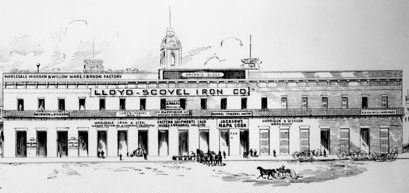
Arcadia Block
Arcadia, NW corner of Los Angeles Street. Built by Abel Stearns in 1858 for $80,000. Razed in 1927.[28]
References
- "Early Los Angeles Historical Buildings (1800s)", Water and Power Associates
- "Los Angeles Fifty Years Ago: The Re-Creation of a Vanished City". Los Angeles Times. November 15, 1931. p. 90. Retrieved 13 May 2019.
- "Temperance Temple", Water and Power Associates
- "U.S. Courthouse, Los Angeles, CA". General Services Administration. Retrieved 13 May 2019.
- https://waterandpower.org/museum/Early_LA_Buildings%20(1800s)_Page_2.html#LA_Times_Building1
- Cal Parks, Site 744
- hmdb.org, Mirror Building
- californiahistoricallandmarks.com 744 -No. 744 Mirror Building - Los Angeles
- https://www.newspapers.com/clip/31677707/coulters_location_1906_225229_s/
- "Ad for Coulter's new store opening". Los Angeles Times. May 31, 1905.
- https://www.newspapers.com/clip/57352206/western-shoe-company-western/
- "The Boston Dry Goods Store". Los Angeles Times. 1 January 1895. p. 29. Retrieved 3 May 2019.
- "The New Boston Store:Los Angeles' Finest Commercial Structure Is Complete". Los Angeles Herald. 4 October 1895. p. 5.
- "CityDig: This Was L.A.'s City Hall for 39 Years". Los Angeles magazine. May 8, 2014. Retrieved 16 May 2019.
- Stern, Norton B. "Louis Phillips of the Pomona Valley" (PDF). Historical Society of Southern California: 184.
- "Architect B. J. Reeve". San Francisco Examiner. August 14, 1887. p. 19. Retrieved 13 May 2019.
- "Buildings and Lands. The July Permits Break the Record. The Remarkable Gains over Last Year's List". Los Angeles Express. August 3, 1895. p. 5.
- "Bullard Block", Los Angeles Water & Power
- https://waterandpower.org/museum/Early_LA_Buildings%20(1800s)_Page_1.html#Temple_Block
- https://waterandpower.org/museum/Early_LA_Buildings%20(1800s)_Page_1.html#Temple_Block
- https://www.newspapers.com/clip/57340846/bullard-block-the-hub-opening/
- "Los Angeles National Bank" and "Equitable Savings Bank", Water and Power Associated
- "Nadeau Hotel", PCAD
- "Bryson-Bonebrake Building, Downtown, Los Angeles, CA (1886-1888) demolished". Pacific Coast Architecture Database. Retrieved 16 May 2019.
- "Hollenbeck Block", Calisphere, University of California
- "Wilcox Building #2". Pacific Coast Architecture Database. Retrieved 16 May 2019.
- "Baker Block", Water and Power Associates
- "Historic Building Is Razed: Flood of Memories Released". Los Angeles Times. May 15, 1927.
_edit1.jpg)